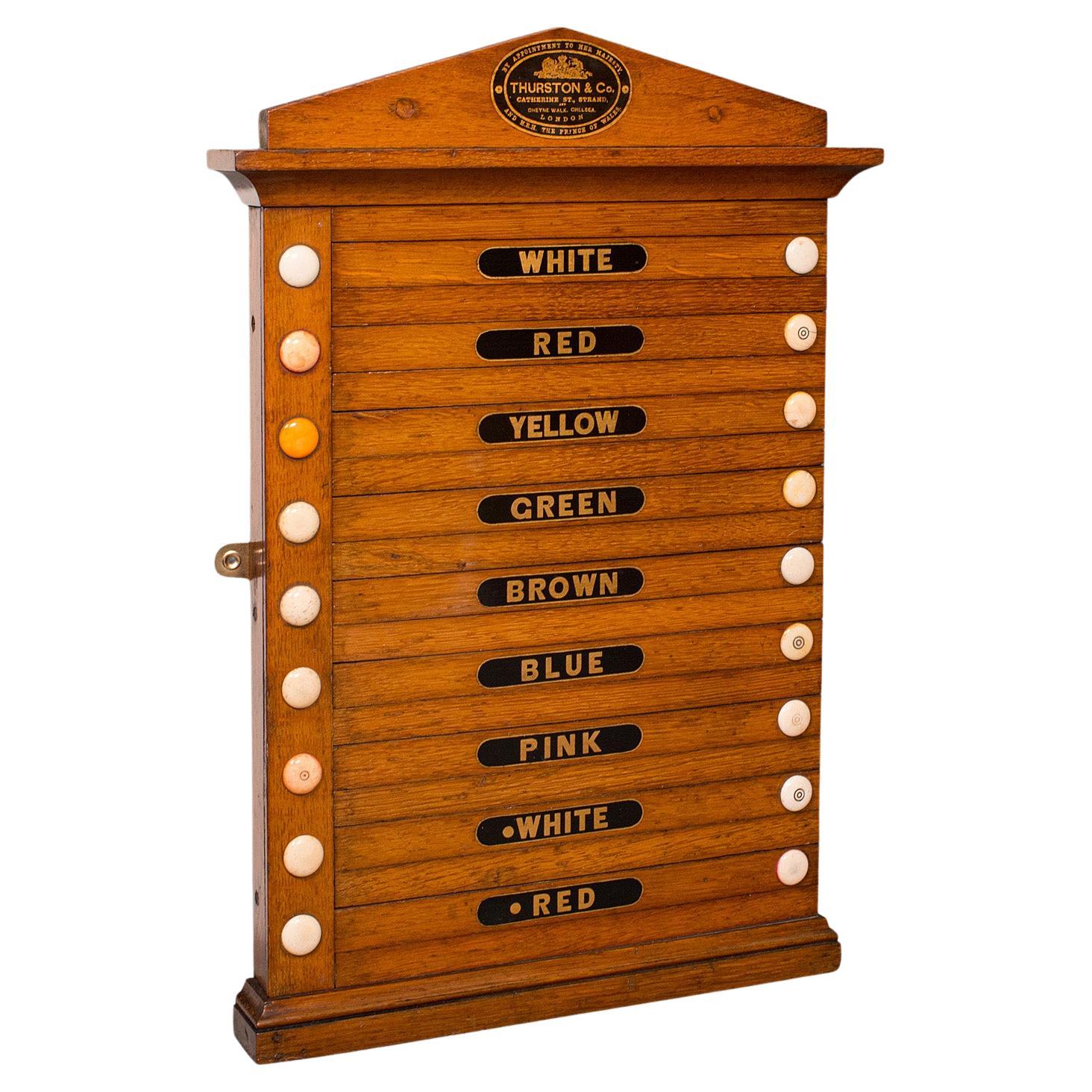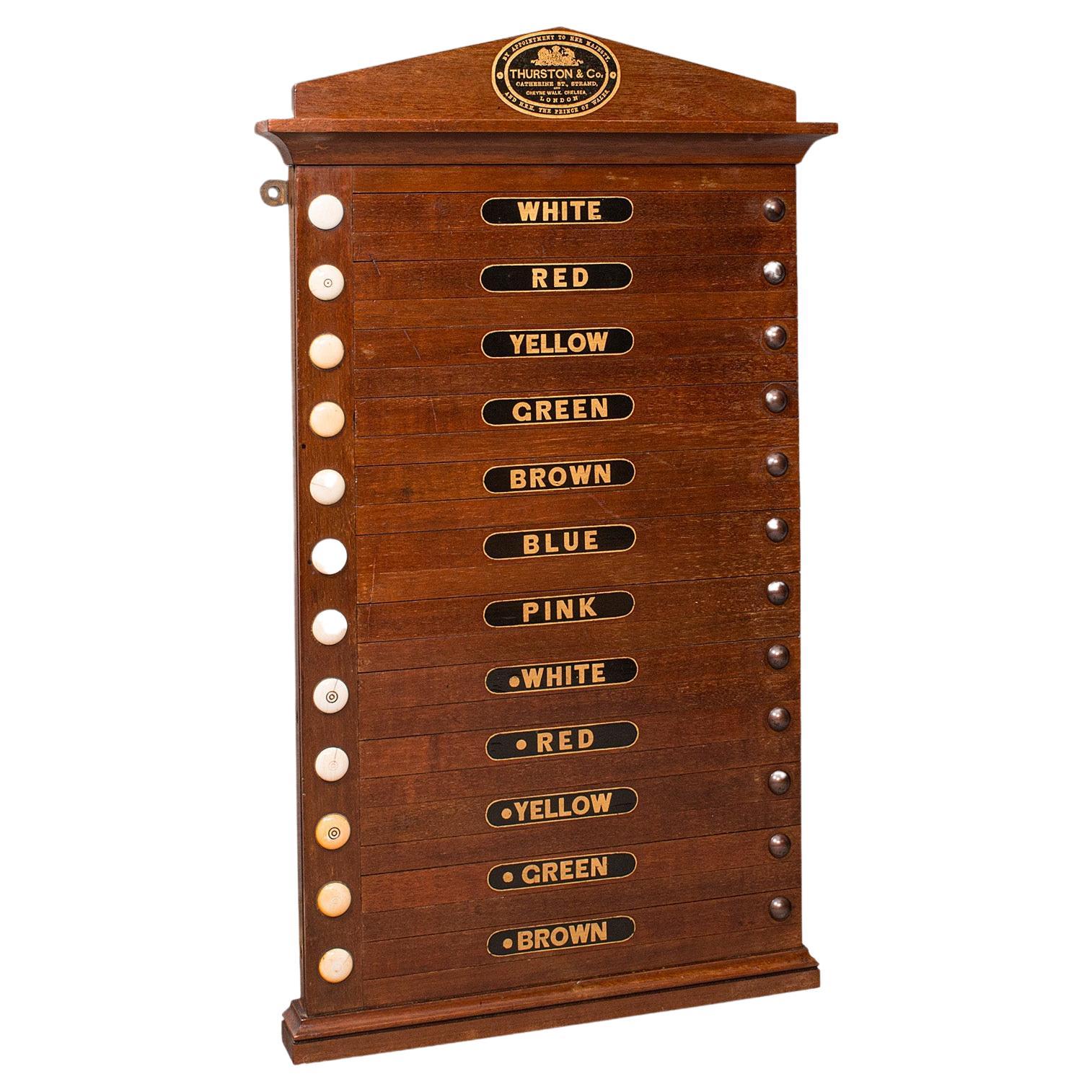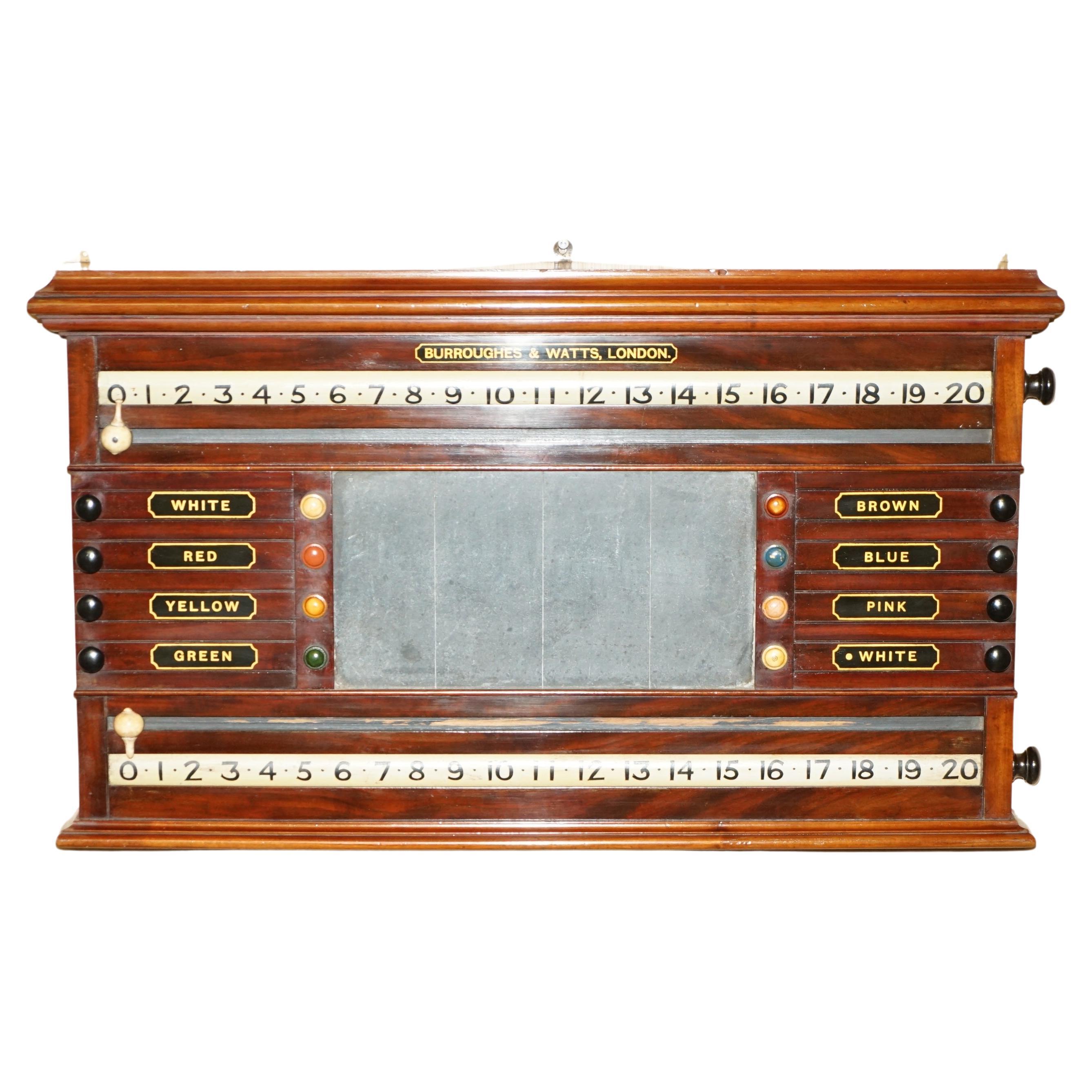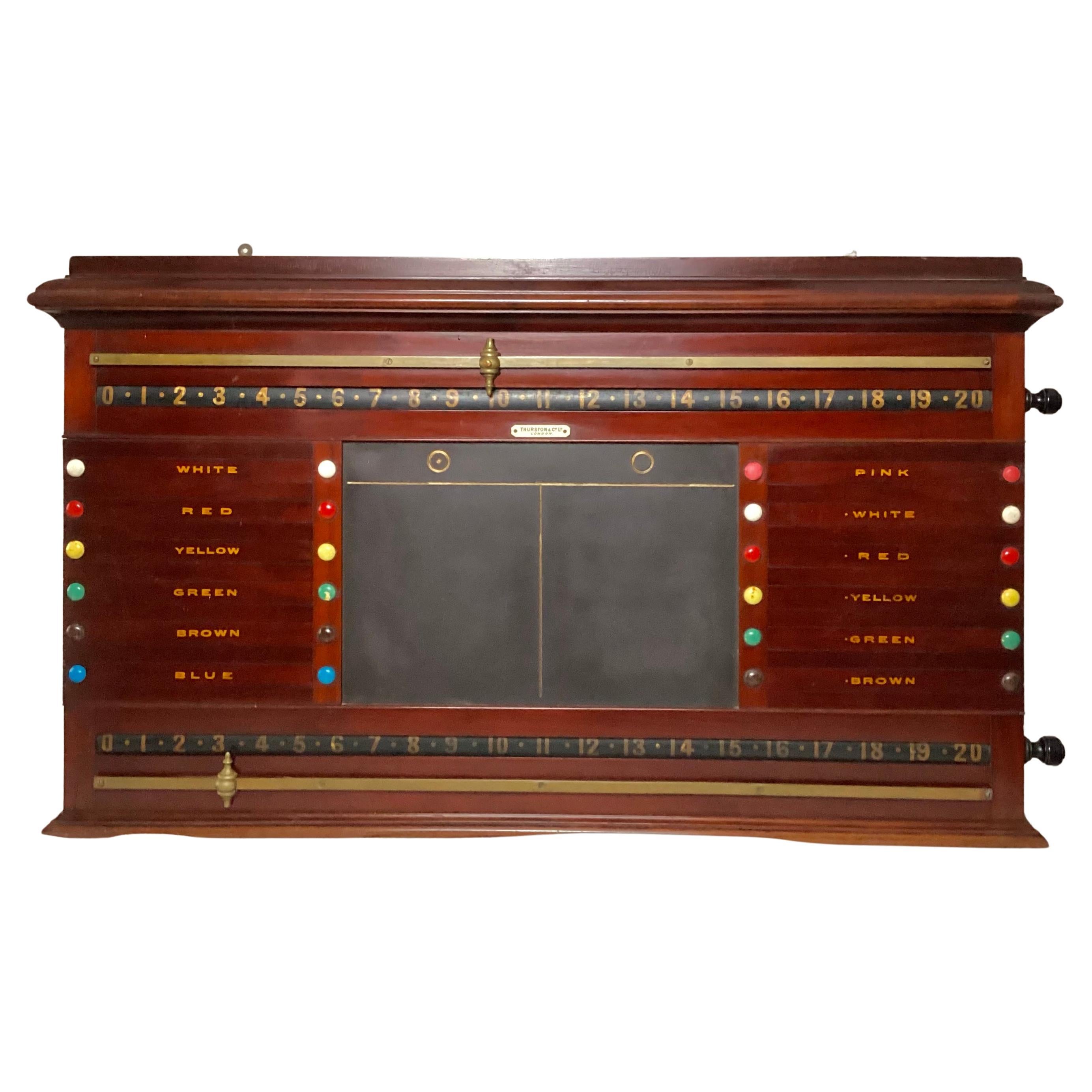Items Similar to Antique Victorian Pool Scoreboard and 2 Prints Palmer & Sons-Joe Davis
Want more images or videos?
Request additional images or videos from the seller
1 of 13
Antique Victorian Pool Scoreboard and 2 Prints Palmer & Sons-Joe Davis
About the Item
This is an excellent antique mahogany pool scoreboard by Palmer & Sons, London late 19th century in date.
This is one of the best examples of a pool scoreboard, with nine slides and a moulded pediment above the maker's label:
PALMER & SONS, 111, HIGH STREET, BORO', LONDON
Together with two prints in oak frames,
THE RULES OF POOL
&
THE RULES OF PYRAMID POOL,
Burroughes & Watts, London.
Provenance:
Sotheby's Belgravia sale on 6th December 1979 of
World Champion Billiards/Snooker player 'Joe Davis'
This is a fun piece which is sure to attract a lot of attention from your guests and be a welcome addition to any games room..
THE BOTANICAL NAME FOR THE MAHOGANY THIS ITEM IS MADE OF IS SWIETENIA MACROPHYLLA AND THIS TYPE OF MAHOGANY IS NOT SUBJECT TO CITES REGULATION.
Condition:
In excellent condition, please see photos for confirmation.
Dimensions in cm:
Height 65 x width 44 x depth 9 - scoreboard
Height 58 x width 41 x depth 2.5 - print with frame
Dimensions in inches:
Height 25.6 x width 17.3 x depth 3.5 - scoreboard
Height 22.8 x width 16.1 x depth 1.0 - print with frame
Burroughes & Watts, London -
firm, which would become one of the most famous of the English billiard table manufacturers, was founded in 1836 by William Burroughes in partnership with F. Watts. William had learnt his trade with Thurston's, and set up his new business at 19 Soho Square, London. He brought with him from Thurston's all the latest innovations for billiard tables, immediately starting to produce models with rubber cushions and slate beds. Even though the natural rubber cushions would give extremes of elasticity according to temperature, and the slates where only an inch thick, this was to be the future of billiard tables, and Burroughes and Watts were at the forefront from the very beginning.
They were quickly recognised as a world-class manufacturer and received a prize medal for a table entered for the Great Exhibition of 1851, with a similar award being received at the subsequent London Exhibition of 1862.
In 1860 they were making a modest 150 full-sized tables a year, but by the end of this decade production had doubled. In 1869 they followed the lead of Thurston's and improved their cushions with "vulcanised" rubber, which were designed to minimise the effect of temperature variations.
The business now looked for expansion away from London, and in the early 1870's they opened up branches in Dublin and Belfast. At this time most tables in Ireland were made with cast iron frames, and the wooden framed Burroughes & Watts tables proved popular with the locals.
In 1873 the company secured a major contract for billiard tables to "Her Majesty's War Department and Admiralty" and around the same time received the warrant of Queen Victorian and Edward, Prince of Wales.
The following year, the champion, William Cook, returned from a tour of America with the idea of running billiard tournaments on a "round-robin" basis rather than the straight knock-out principle which had hitherto been used in England. Cook mentioned the idea to Mr. J. S. Burroughes who was sufficiently impressed to promote a tournament, putting up prize money of £100.
By 1875 provincial showrooms and offices had been established in Manchester, and expansion increased with a branch at Newcastle in 1890, by which time agencies had also been established in Australia and New Zealand. In 1893 showrooms were opened in Glasgow, and by the end of that decade, premises in Birmingham and Sheffield were also operating.
Burroughes & Watts were more active in the provinces than any other London maker, and in 1876 they established the Scottish Professional Billiards Championship, providing a silver challenge cup.
Although new models of tables continued to be produced, Burroughes & Watts lagged somewhat behind their competitors when it came to their cushions. Most English manufacturers had switched to the use of strip-rubber from about 1910, and rather belatedly, this feature was incorporated into the Eureka Vacuum cushion in 1922.
However an excellent reputation of The Burroughes & Watts continued into the 1950's and early '60's through now with household names such as Ray Reardon, Cliff Wilson, Joe and Fred Davis, Gary Owen and Rex Williams.
- Dimensions:Height: 25.6 in (65 cm)Width: 17.33 in (44 cm)Depth: 3.55 in (9 cm)
- Style:Victorian (Of the Period)
- Materials and Techniques:
- Place of Origin:
- Period:
- Date of Manufacture:circa 1890
- Condition:
- Seller Location:London, GB
- Reference Number:
About the Seller
5.0
Platinum Seller
These expertly vetted sellers are 1stDibs' most experienced sellers and are rated highest by our customers.
Established in 1983
1stDibs seller since 2012
1,203 sales on 1stDibs
Typical response time: <1 hour
Associations
LAPADA - The Association of Arts & Antiques Dealers
- ShippingRetrieving quote...Ships From: London, United Kingdom
- Return PolicyA return for this item may be initiated within 14 days of delivery.
More From This SellerView All
- Antique Teak and Brass Set 4ft 8-Spoke Ships Wheel, 19th CenturyLocated in London, GBThis is an elegant and large antique Victorian teak and brass set ships wheel, circa 1880 in date. This splendid nautical collectable features eight stylish turn king cylindrical spokes ending in handles, and is made from beautiful high-quality solid teak which displays a gorgeous and prominent patina. It has wonderful brass mounts around the circumference on both sides as well as on the hub, which add an extra touch of luxury and redefined style to the entire piece. It is in truly excellent condition and highly decorative, making it perfect as a sumptuous home wall decor...Category
Antique 1880s English Victorian Nautical Objects
MaterialsBrass
- Vintage English Silver Walking Stick Cane William Comyns & Sons 2007By William ComynsLocated in London, GBThis is a beautiful vintage sterling silver pommel walking stick bearing hallmarks for London, dated 2007, by the renowned silversmith William Comyns & Sons. The striking stick fea...Category
Early 2000s Sports Equipment and Memorabilia
MaterialsSilver
- Antique Victorian Sterling Silver Casket by William Comyns & Sons 1898By William Comyns & Sons 1Located in London, GBThis is an elegant antique Victorian sterling silver casket with hallmarks for London, 1898 and the makers marks of the renowned silversmith William Comyns & Sons. The shaped casket...Category
Antique 19th Century English Victorian Sterling Silver
MaterialsSterling Silver
- Antique Victorian Walnut Writing Table Desk Hindley & Sons 19th CenturyLocated in London, GBAntique Victorian walnut writing table, circa 1850 in date. One of the drawers is stamped by the maker: C.Hindley & Sons, late Miles & Edwards, 134 Oxford Street, London. It bears the inventory number 12451 The rectangular top features a moulded edge with a striking inset red leather writing surface over two cedar lined drawers to the frieze, fitted with Bramah locks. It is raised on four decorative barley twist legs terminating in brass castors. It is finished on all sides so that it can stand freely in the middle of a room. Complete with working Bramah locks and special key. Condition: In excellent condition, please see photos for confirmation. Dimensions in cm: Height 76 x Width 123 x Depth 69 Dimensions in inches: Height 2 foot, 6 inches x Width 4 foot x Depth 2 foot, 3 inches Hindley, Charles & Sons Berners Street & Oxford Street, London; cabinet makers, upholsterers and retailers (fl.c.1820-1892) Charles Hugh Hindley (b.1792- d.1871) was the son of Christopher, a merchant in Mere, Wiltshire. He moved to London with an elder brother to live with his uncle, who was possibly running the London branch of the Wiltshire business. In 1817 Charles joined the upholstery firm of Benjamin Merriman Nias at 32 Berners Street. Within a few years he bought the Nias business with a £1,000 investment from his family. Despite his business being described as a 'carpet warehouse' in London directories from 1820-1841, by the mid-1830s upholstery and cabinet work had joined his repertoire and he had taken on more showroom space next door at 31 Berners Street. Family records of the 1840s showed that individual custom-order business expanded to also ‘supplying established furnishing houses with goods on wholesale terms’. Jobs ranged from supplying Pentonville Prison with 100 hair mattresses and pillows, to altering spring roller blinds, to fulfilling private commissions with suites of parlour furniture. Hindley was the father of eleven children with three involved in the business: Charles Hugh (b. 1818), Frederick (b. 1820), and Albert Daniel (b.1822). Charles Hugh and Frederick joined the family firm about 1832, thus establishing the family partnership, Charles Hindley & Sons. Albert Daniel learned the carpet manufactory and trade in Kidderminster and eventually established a carpet manufactory in Liversedge, Yorkshire, supplying the family’s London store and others. In 1845 he patented an early tufted carpeting technique. Charles Hindley & Sons acquired the firm, Miles & Edwards in September 1844, including their premises at 134 Oxford Street. Both companies operated from this address until 1845 when Miles & Edwards was closed. The purchase of Miles & Edwards enabled Hindley & Co. to compete with other West End firms by offering everything from cabinet making and upholstery to painted decoration and interior design for the middle and upper class market. In a sample of 737 orders from October 1842-June 1845, six per cent of the clientele were upper and lower aristocracy with approximately seventy per cent gentry or middle class. The aristocratic clientele included the surnames of Hoare, Kirland, Drummond, Montefiore, Ashburton and Rothschild, and the Oriental Club at 18 Hanover Square (1824). Bramah is London's oldest security company. Established at 124 Piccadilly, London in 1784, and today based in Marylebone, London and Romford, Essex. Bramah made their first lock in 1784 and the patent was awarded in 1787. The designer was Joseph Bramah. Joseph Bramah was a leading inventor of the industrial revolution, patenting over 18 new ideas, including a new valve for the water closet (toilet), the hydraulic pump, a fountain pen, and a fire engine. Bramah also introduced a beer hand pump for use at the bar, to prevent fluid loss when barmen went downstairs to pour a new jug! Due to the quality of his manufacturing, his name became a by-word amongst British Engineers for engineering excellence and many of his inventions are on display in the Science Museum in London. You can find one of his original toilets still working in Osborne House, Queen Victoria's home on the Isle of Wight. The Bramah lock was unique and advanced property and valuables protection enormously. Indeed it was 50 years ahead of any Chubb lock...Category
Antique 1850s English Victorian Desks and Writing Tables
MaterialsWalnut
- Antique Victorian Silver Plated Sugar Caster William Batt & Sons 1860, 19th CLocated in London, GBA large beautiful Victorian silver plated sugar caster made by William Batt & Sons Ltd, circa 1860 in date. It features typical baluster form and is embossed with lavish decorati...Category
Antique 1860s English Victorian Sheffield and Silverplate
MaterialsSilver Plate
- Antique Walking Stick Cane 9 Ct Gold Pommel, Late 19th CenturyLocated in London, GBThis is an exquisite antique Victorian walking cane with a 9ct gold pommel, dating from the late 19th Century. The gold handle is round in sh...Category
Antique 1890s English Victorian Sports Equipment and Memorabilia
MaterialsGold
You May Also Like
- Antique Life Pool Scoreboard, English, Oak, 9 Player, Thurston and Co, VictorianLocated in Hele, Devon, GBThis is an antique life pool scoreboard. An English, oak 9 player board by Thurston & Co, dating to the late Victorian period, circa 1900. Fascinating antique scoreboard...Category
Antique Late 19th Century British Sports Equipment and Memorabilia
MaterialsOak
- Antique Life Pool Scoreboard, English, 12 Player, Billiards, Thurston, VictorianLocated in Hele, Devon, GBThis is an antique life pool scoreboard. An English, mahogany 12 player board by Thurston & Co, dating to the late Victorian period, circa 1900. Charming ...Category
Antique Late 19th Century British Sports Equipment and Memorabilia
MaterialsWood
- FULLY RESTORED ANTiQUE VICTORIAN BURROUGHES & WATTS LONDON SNOOKER SCOREBOARDBy Burroughes & WattsLocated in GBRoyal House Antiques Royal House Antiques is delighted to offer for sale this absolutely exquisite fully restored Burroughes & Watts London Mahogany Snooker scoreboard A truly stunning example of Victorian Snooker...Category
Antique 19th Century English Victorian Sports Equipment and Memorabilia
MaterialsHardwood
- Victorian Oak Billiard, Lifepool Scoreboard with CabinetLocated in Oxfordshire, GBSnooker, Billiards & Life pool scoreboard attributed to Thurston & Co. A nice combined Victorian billiards and life pool scoreboard made of light oak. The billiard scorer sits upon a lockable ball cabinet that can house 32 balls, which then sits upon a cupboard. The cupboard comprises of two drawers, a pair of panelled doors enclosing a shelf, the cupboard raised on a plinth base. The scorer comprises of two blue rollers with gilt painted numbers, 0 to 20 / 20 to 40 / 40 to 60 / 60 to 80 / 80 to 100, with two ebony slides to mark your score, one spot and one plain. The Life Pool board consists of 12 slides with coloured discs, each colour representing the player's cue ball and the order of play. The colours of the discs being blue, brown, green, white, red, yellow, black, pink, spot orange, spot white, spot red and spot yellow. When each slide is pulled back 3 boxwood discs are revealed, one for each life of the player. There are also "stars" hiding, and these are used as extra lives. In the middle of the scoreboard there is a slate board for keeping scores etc. The game of Life Pool can be played by a number of players, a maximum of 12 players with this scoreboard, who form the pool. Each player has their own coloured ball and loses a life each time the ball is potted by an opponent. When three lives...Category
Antique 1880s British Sports Equipment and Memorabilia
MaterialsOak
- Antique Billiard Marker or POOL Scorer Victorian Barcelona SpainLocated in Radstock, GBAn exquisite and exceptiionally rare Spanish billiard marker by Mayol Y Poch of Barcelona circa 1880. Probably made from Madera wood. A high end ...Category
Antique 1880s Spanish Late Victorian Games
MaterialsWalnut
- Antique Thurston & Co Ltd London Snooker Billiards ScoreboardLocated in Lambertville, NJAntique Thurston & Co LTD London Snooker Billiards Scoreboard. This is a great example of English craftsmanship made of mahogany late Victorian. The slate is in wonderful condition. ...Category
Antique Late 19th Century English Late Victorian Games
MaterialsSlate





